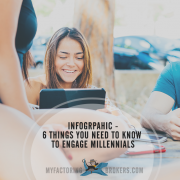Creating a Baby Boomer-friendly customer experience is so 5 minutes ago. With mobile millennials now making up 25 percent of the U.S. population overall and nearly half of all B2B buyers, it is time to revisit your customer experience marketing strategy.
5 Tips for Marketing to Mobile Millennials for Retail and B2B Sellers
With one in four Americans and almost half of all B2B buyers now among those referred to as mobile millennials, small wonder that “customer experience” was identified as the most exciting opportunity for marketers this year. Here are some insights that you can use to improve your customer experience for millennials (and everyone else, too).
Generally speaking, those born between 1977 and the turn of the century (year 2000) are considered ‘millennials,’ so named for the turn of the millennium when 1999 became 2000. There are more than 80 million millennials in the U.S. and they now make up about one fourth of the U.S. population. There are more millennials than Baby Boomers and the millennial generation is 20 percent bigger than their predecessors in Generation X.
Millennials and Buying Power
When it comes to buying power, mobile millennials make 21 percent of consumer discretionary purchases – more than a trillion dollars in direct buying power. In addition, they contribute significantly to the buying decisions of other generations. Some of the traits that characterize their shopping and brand engagement habits include:
- an interest in being part of the brand story, even helping to create content
- affinity for products or services that contribute to a healthier lifestyle
- a tendency to seek and rely on peer affirmation
- an addiction to mobile devices and social media
- an appetite for cause marketing and brands that are aligned with a greater purpose
In fact, 69 percent of millennials worldwide want businesses to make it easier for consumers to get involved in societal issues.
Millennials, Socially Speaking
47 percent of Americans say Facebook is their #1 influencer of purchases; 63 percent of millennials say they stay updated on brands through social networks (webmag.co, The Future of Customer Experience).
77 percent of all social media users access social networks via mobile devices; since nine out of ten millennials have cell phones, it seems safe to assume that the percentage of mobile millennials who access social networks on mobile devices is higher than the overall population.

As of June 2014, millennials use of popular social media apps broke down this way:
- 76% – Facebook
- 43% – Instagram
- 33% – Snapchat
- 24% – Twitter
- 18% – Google+
- 18% – Pinterest
- 11% – Vine
- 6% – Tumblr
Millennials Growing Influence as B2B Buyers
A new study by Google and Millward Brown asserts that 46 percent of potential buyers researching B2B products were millennials in 2014, up from just 27 percent in 2012. Mobile device use among those researching B2B purchases is also on the rise. In 2014, 34 percent of B2B buyers used mobile devices at various stages across the buying journey, up from 18 percent in 2012.
Use of video in the B2B buying journey has also come into its own with 70 percent of B2B buyers accessing video at some point during the buying process in 2014, up from 46 percent in 2012. While Baby Boomers account for just 20 percent of digital video views, millennial viewers account for four out of every ten digital video views, according to eMarketer.com.

5 Ways to Make Way for Millennials in the Customer Experience
Assume a Mobile-Only or Multi-Device Buying Process
If your website is not yet mobile friendly, you stand to lose traction with buyers from every generation in a few short weeks when Google says they will update their algorithm and display more mobile-friendly websites in search results. Organic search imperatives aside, today’s marketer must adopt an omni-channel marketing approach that assumes buyers will use multiple devices during the buying process, and sometimes using several different device types along any one particular buying journey, depending on the length of the buying cycle.
Retailers in particular must assume that many buyers will use only mobile devices, and ensure that their website displays effectively for the small screen, can be easily navigated and loads quickly.
Build Social Brand Proof Into Your Brand
Whether you are engaging followers on social networks through status updates, published content, sponsored posts, or responding to comments and updates of other social media users, millennials affinity for (constant) use of social networks can work to your advantage. Use social channels to ask for testimonials, reviews, user-generated videos, user-created-content, etc. Then, promote customer-created social proof on your social networks.
In addition to social networks, in “10 New Findings About the Millennial Consumer,” Forbes.com notes that one third of mobile millennials review blogs before making a purchase. Creating advertorial content and infusing customer reviews into product and service-related blog content are two strategies that can help convert more sales.
Advertising is Out (Way Out!), Authenticity is In
Today’s mobile millennials were among the earliest digital natives; as such, they know how to ignore advertisements, perhaps more so than any preceding generation. Couple this innate ability with the cacophony of marketing messages the consumer is exposed to in any given day, and it’s clear that brands must re-think the way they promote goods and services to this generation. Hands-on experiences, first hand testimonials, brand transparency, honesty when things go wrong – all of these tactics can help present your brand in a positive, authentic light to this generation.
Add Altruistic Value
Given the millennials affinity for products, services and brands that contribute to a healthier lifestyle as well as the fact that they are more likely to do business with brands when doing so is more provides a greater good than just “doing business,” cause marketing might be a great way to add perceived value to your brand.
Embrace Shared-Control of Brand Identity
The old saying, ‘children should be seen and not heard‘ has no place when it comes to the youngest group of adult consumers in the U.S. today. Millennials are used to being heard and having their opinions taken into consideration. Instead of trying to control brand identity from the inside-out, embrace the idea of shared control.
As you let millennials help to define your brand and further influence consumer perception, you may even find that they painted a prettier – and more profitable – picture of your brand than you could have done on your own. What’s more, as “part owners” of your brand’s identity, millennials are much more likely to do you the favor of endorsing your brand among their peers as well.
You might also like: Move Over Millennials: Make Way for Gen Z [Infographic]








Trackbacks & Pingbacks
[…] You might also like: Mobile Millennials and the Coming Customer Experience Apocalypse […]
[…] question isn’t whether mobile will be playing a part in your customer’s buying journey, but when. Depending on the complexity of the buying journey, […]
[…] (Image source) […]
Leave a Reply
Want to join the discussion?Feel free to contribute!